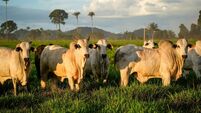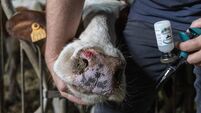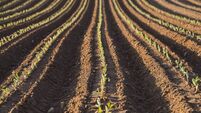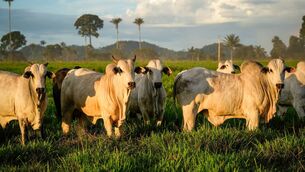Setting up your indoor beef finishing plan

Beef finishers should always aim to keep production costs under control to optimise profits, writes ruminant nutritionist Brian Reidy.
Over the last week, I have been visiting some of my beef finishing customers to start constructing diets for the coming months. Due to concerns over having sufficient supplies of grass silage, the conversations have regularly moved towards discussing alternative feeds and bye products to fill the gap and achieve animal performance.
Beef finishers should always aim to keep production costs under control to optimise profits. How this is achieved is multifactorial.
Many questions need to be asked as plans are made for the coming feeding season:
- What is my target market?
- What are my cattle capable of gaining each day?
- What is my forage quality?
- How much forage dry matter is currently in the yard?
- What concentrates are available to me and at what cost?
- Are sheds suitable for my feeding strategy and performance targets?
- If new feeds are introduced, are storage facilities available and appropriate?
Production efficiency is relevant every year and this year in particular, two factors stand out as the price of cereals are very competitive and there is not a plentiful supply of silage in yards.
Straw is also in low supply and has increased significantly in price. With this in mind, getting the balance right for optimum performance may not always be easy this year. When forage is scarce and extra concentrates must be fed to finishers, it is so important to be feeding an appropriate ration which balances available forage and does not cause digestive upsets.
At this stage of the year, grass quality is decreasing rapidly. It’s energy, fibre and dry matter content always drop from late August, regardless of previous growth or weather conditions. It is always a good idea to feed some concentrates to finishers prior to housing.
Many are considering housing finishers sooner rather than later in order to prevent them from going backwards. Once is enough to put weight on cattle. I visited a farm earlier in the month that already has most of its cattle to be finished pre-Christmas housed with two weeks at this stage. These cattle are looking really well and have settled into their diet well with no setbacks. Don’t wait until grass has run out to house them!
The first thing to do with finishing cattle is to set out your goals for them. Firstly, you need to establish current liveweight.
- What market are you targeting for your stock?
- What carcass weight is required?
- Are there weight restrictions?
- What confirmation is required?
- Breed and sex will determine their potential weight gain.
- Don’t expect bull performance from bullocks!
- What housing type will they be accommodated in.
- When do you want or need to slaughter them?
- Are there age restrictions?
You really must test your silage to increase feeding accuracy. Your silage quality will determine your feeding and management strategy for all stock this winter.
I have now been using my mobile NIR4 for over eight years and it continues to be a vital part of the service I provide. Accurate forage analysis is so important in order to construct cost effective diets for efficient finishing of stock.
- As I wrote last week, some have already discovered that the silage they have is not as good as they expected as a lot of grass was too mature when harvested this year. Some have very dry silage this year, which has not preserved very well. This silage will need very careful management at feedout.
- Your animal’s ability to consume silage in large volumes will be the first factor to consider. Does your silage have good intake characteristics?
- Maize silage looks decent this year and the prospects for good yields with high starch are very good. Most crops will not be ready for harvest until well into October, patience is needed as harvesting it too early will result in significant nutrient loss from the pit.
- Beet yields look very promising. If you are buying or have grown your own beet then work out your tonnage available and again, spread it out over the entire feeding season. There is nothing worse than running out of beet in finishing diets. Cattle will get very upset, and intakes often collapse resulting in delayed slaughter.
- Beet wont save silage, as it drives increased intakes, so bear this in mind if you need to stretch silage.
By-products, such as brewer's and distiller's grains, seem to be available at present and are excellent feeds to promote intakes and they also provide a good source of protein for finishing stock.
When purchasing concentrates for finishing stock, it is important that it has high energy. Ask your supplier to give you a list of ingredients and get the UFL or ME value of the mix before purchasing. The higher the energy the quicker the finish.
Look for mixes high in cereals as starch will improve finish and fat cover. Rations really should be bought based on their energy content and ingredient quality rather than their protein percentage. Introduce concentrates gradually to finishers in order to prevent digestive upsets, such as acidosis. Maintaining a healthy rumen pH is critical if you want to achieve good animal health and performance.
Basic mineral elements such as Calcium, Phosphorous and Sodium are essential for basic functions such as saliva production for rumen buffering. Minerals and vitamins help to manufacture vital enzymes which aid thorough feed digestion and influence animal performance and feed efficiency. It is never a good idea to feed finishing animals without providing a good quality mineral supplement.
- Brian Reidy is an independent ruminant nutritionist at Premier Farm Nutrition.











